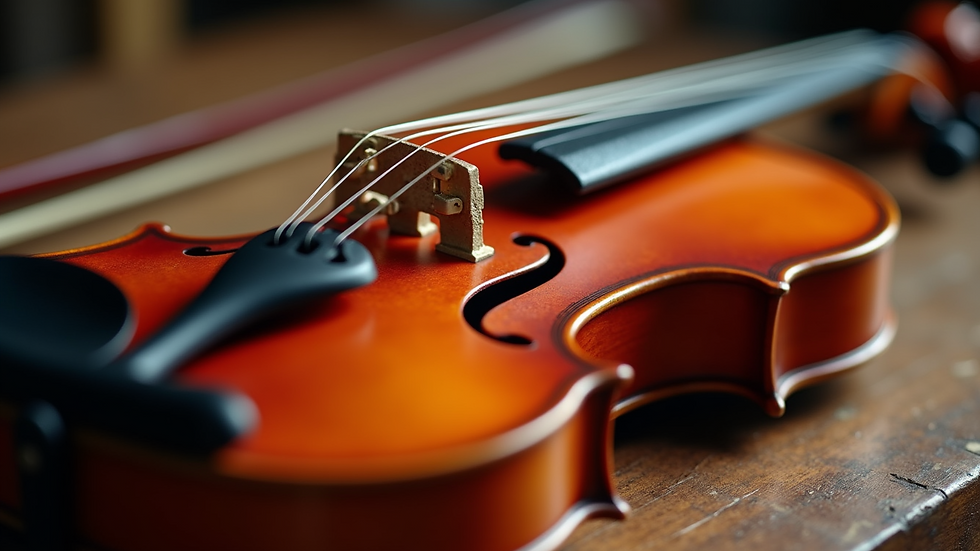Step-by-Step Beginner Violin Lessons
- BROOKLYN MUSICALS
- Aug 4
- 3 min read
Learning the violin can be a rewarding and fulfilling experience. Whether you dream of playing classical masterpieces or simply want to enjoy the beauty of this string instrument, starting with the right approach is essential. This guide will walk you through the basics of introductory violin classes, helping you build a strong foundation and develop your skills step by step.
What to Expect in Introductory Violin Classes
Introductory violin classes are designed to help beginners become familiar with the instrument and its fundamentals. These classes typically cover:
Holding the violin and bow correctly: Proper posture and grip are crucial for producing a good sound and avoiding injury.
Basic music theory: Understanding notes, rhythms, and simple sheet music.
Playing open strings: Learning to produce clear tones on the four strings.
Simple melodies: Playing easy songs to build confidence and technique.
In these classes, you will also learn how to tune your violin and care for it properly. The goal is to make you comfortable with the instrument and excited to practice regularly.

Essential Equipment for Your Introductory Violin Classes
Before starting your lessons, it’s important to have the right equipment. Here’s what you will need:
A violin: Choose a size that fits your body. For adults, a full-size violin (4/4) is standard. For children, smaller sizes are available.
A bow: Usually comes with the violin, but quality varies.
Rosin: Applied to the bow hair to help it grip the strings.
Shoulder rest: Provides comfort and support while holding the violin.
Tuner: Helps you keep your violin in tune.
Music stand: Holds your sheet music at eye level.
Make sure your violin is properly set up by a professional to avoid frustration. Many music stores offer rental options, which can be a cost-effective way to start.

How much do beginner violin lessons cost?
The cost of beginner violin lessons varies depending on several factors such as location, instructor experience, and lesson format (in-person or online). On average, you can expect:
Private lessons: $30 to $60 per 30-minute session.
Group classes: $15 to $30 per session, often lasting 45 to 60 minutes.
Online courses: Prices range widely, from free tutorials to subscription-based platforms costing $20 to $50 per month.
Some music schools offer package deals or discounts for multiple lessons booked in advance. It’s a good idea to research local options and read reviews before committing. Remember, investing in quality instruction will pay off in your progress and enjoyment.
First Steps: Learning to Hold and Play the Violin
Starting with the basics is key to success. Here’s a simple step-by-step approach to your first practice sessions:
Holding the violin: Rest the violin on your left shoulder, supporting it with your chin on the chinrest. Keep your back straight and shoulders relaxed.
Holding the bow: Use your right hand to grip the bow gently but firmly. Your thumb should be bent and placed near the frog (the end part of the bow).
Playing open strings: Practice drawing the bow across each string smoothly. Aim for a clear, steady sound.
Finger placement: Once comfortable with open strings, start placing your fingers on the fingerboard to change notes. Use finger tapes or markers if needed.
Simple exercises: Play scales and easy songs to develop finger strength and coordination.
Consistency is important. Try to practice daily, even if only for 10-15 minutes. This builds muscle memory and improves your tone.

Tips for Making the Most of Your Introductory Violin Classes
To get the best results from your lessons, keep these tips in mind:
Set realistic goals: Focus on small achievements like mastering a scale or a simple song.
Practice regularly: Short, frequent practice sessions are more effective than occasional long ones.
Record yourself: Listening to recordings helps identify areas for improvement.
Stay patient: Progress takes time, and mistakes are part of learning.
Ask questions: Don’t hesitate to seek clarification from your instructor.
Use quality resources: Supplement your lessons with books, apps, and videos.
If you are looking for structured and supportive beginner violin lessons, consider enrolling in beginner violin lessons that offer step-by-step guidance tailored to your pace.
Building Confidence and Enjoying Your Violin Journey
Learning the violin is a journey filled with challenges and rewards. Celebrate your progress, no matter how small. Playing music can boost your creativity, relieve stress, and connect you with others.
As you advance, explore different styles and pieces that inspire you. Join local ensembles or online communities to share your passion. Remember, every expert was once a beginner.
With dedication and the right instruction, your introductory violin classes will set the stage for a lifetime of musical enjoyment. Keep practicing, stay curious, and let the music flow!



Comments